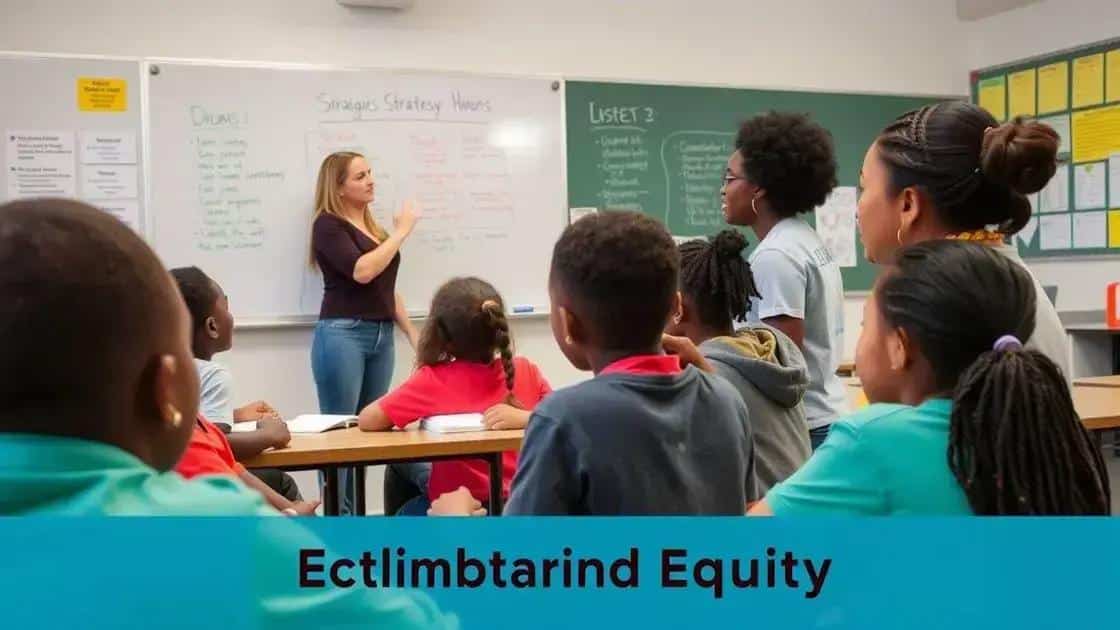Diversity equity inclusion schools u.s: Why it matters
Anúncios
Diversity, equity, and inclusion in schools are essential for fostering a supportive learning environment that enhances academic success and social development for all students.
Diversity equity inclusion schools u.s are more than just buzzwords; they represent a transformative approach to education. As schools become more diverse, fostering an inclusive environment helps all students thrive. What does this mean for our future leaders?
Understanding diversity, equity, and inclusion
Understanding diversity, equity, and inclusion is essential for creating a vibrant learning environment in schools. These concepts help to foster mutual respect among students and promote a culture of acceptance.
In this section, we will explore what each term means and why they are crucial for education.
Diversity
Diversity refers to the variety of differences among people. It includes race, ethnicity, gender, sexual orientation, socio-economic status, and ability levels. Recognizing diversity allows students to appreciate different backgrounds and viewpoints.
Equity
Equity means ensuring fair treatment, opportunities, and advancement while striving to identify and eliminate barriers that have historically led to unequal treatment. This concept is about recognizing the unique needs of each student and providing the right support they need to succeed.
Inclusion
Inclusion involves creating a learning environment where all students feel valued and engaged. When schools embrace inclusion, they empower every student to participate fully in classroom activities, no matter their background or abilities.
Why They Matter
These three components work together to reduce discrimination and promote a positive atmosphere in schools. Here are some reasons why they are important:
-
🌍 They prepare students for a diverse world.
-
📚 They improve academic outcomes for all students.
-
🤝 They promote respect and understanding among peers.
-
🏘️ They help build strong communities.
Embracing diversity, equity, and inclusion not only benefits students but also contributes to a rich educational experience that fosters growth and learning.
The impact of diverse classrooms on student success

The impact of diverse classrooms on student success is profound. When students learn in an environment that celebrates differences, they are more likely to excel academically and socially.
Research shows that diversity enhances critical thinking skills. Students learn to view challenges from multiple perspectives, which strengthens their problem-solving abilities.
Benefits of Diverse Classrooms
A diverse classroom brings together students from various backgrounds. This exposure leads to numerous benefits:
- Increased creativity and innovation.
- Improved cultural awareness.
- Better preparation for a global workforce.
- Stronger communication skills.
As students engage with peers from different cultures, they develop empathy and respect. This not only fosters a sense of belonging but also enhances collaboration.
Academic Outcomes
Diverse classrooms can lead to improved academic performance. Students are motivated to succeed when they witness their peers overcoming challenges and excelling. They are also more likely to participate in discussions, sharing their unique insights, which enriches the learning experience for everyone.
Furthermore, teachers who incorporate diverse perspectives into their lessons can create more engaging and relevant content. This helps all students connect with the material, leading to higher retention rates and a deeper understanding.
Ultimately, the positive impact of diverse classrooms on student success is clear. The collaboration and understanding fostered in these settings prepare students not just for school, but for life beyond the classroom.
Strategies for implementing inclusion in schools
Implementing inclusion in schools requires thoughtful strategies that benefit all students. These practices help create an environment where every student feels welcomed and valued.
One of the first steps is to provide training for teachers. Educators should understand the diverse needs of their students. This knowledge equips them to adapt their teaching styles effectively.
Building an Inclusive Curriculum
A key strategy is to develop an inclusive curriculum that reflects the diversity of the student body. This means incorporating different perspectives and allowing students to see themselves in the material being taught.
-
📚 Use diverse resources that represent various cultures.
-
🌍 Integrate multicultural education across subjects.
-
🗣️ Encourage students to share their own stories.
-
🎓 Adapt lessons to include all learning styles.
Alongside the curriculum, fostering a supportive classroom environment is crucial. Teachers should encourage collaboration and teamwork among students. When they work together on projects, they learn to appreciate each other’s strengths.
Creating Support Systems
Another important aspect is establishing support systems for students. This might include mentoring programs or peer tutoring. Having older students mentor younger ones can help build connections and confidence.
Additionally, schools can provide resources for students who need extra help, such as counseling services or learning accommodations. By addressing individual needs, schools can ensure that everyone has the opportunity to succeed.
Finally, engaging parents and the community fosters a shared responsibility for inclusion. Schools can host workshops or meetings to inform families about inclusion initiatives. When parents are involved, it strengthens the support network for all students, making the school a more inclusive place.
Challenges and solutions in promoting equity

Promoting equity in schools comes with various challenges, but addressing these issues is essential for creating fair learning environments. Understanding these challenges helps in developing effective solutions.
One of the main challenges is resource allocation. Many schools lack the funding necessary to provide all students with equal opportunities. This often leads to disparities in educational quality, affecting low-income families more severely.
Identifying Barriers
Another significant barrier is bias. Both conscious and unconscious biases among teachers can affect how they interact with students. These biases may impact grading, participation, and access to advanced courses, leading to unequal outcomes for students from different backgrounds.
-
🧠 Recognizing implicit biases in educators.
-
📚 Ensuring access to advanced classes for all students.
-
🌟 Creating a supportive environment for marginalized students.
-
🎓 Offering faculty training on equity and inclusion.
Furthermore, communication gaps between schools and families pose a challenge. Parents may not be aware of available resources or programs that support their children’s education. This lack of information can hinder students’ access to necessary support.
Effective Solutions
To overcome these obstacles, schools must actively engage all stakeholders, including students, parents, and community members. Open discussions about equity can raise awareness and foster collaboration in finding solutions.
Conducting regular training on equity for teachers is crucial. This training can help educators recognize their biases and adjust their teaching methods accordingly. Additionally, schools can develop mentorship programs that connect students with role models from underrepresented backgrounds.
Lastly, improving communication with families can bridge gaps in understanding. Schools should provide clear information on resources, academic programs, and support services available to students.
In summary, promoting diversity, equity, and inclusion in schools is crucial for creating a better learning environment for all students. By understanding the challenges and implementing effective strategies, schools can foster a supportive atmosphere. These efforts not only benefit individual students but also strengthen entire communities. Working together, educators, families, and students can ensure that every child has equal opportunities to succeed.
FAQ – Questions about diversity, equity, and inclusion in schools
Why is diversity important in schools?
Diversity is important because it fosters understanding and respect among students, enhancing their social and academic experiences.
What challenges do schools face in promoting equity?
Schools often face challenges such as resource allocation, bias among educators, and communication gaps with families.
How can teachers promote inclusion in the classroom?
Teachers can promote inclusion by using diverse teaching materials, encouraging collaboration, and providing support for all students.
What role do families play in promoting equity?
Families play a crucial role by engaging with schools, advocating for their children, and participating in discussions about equity and inclusion.






